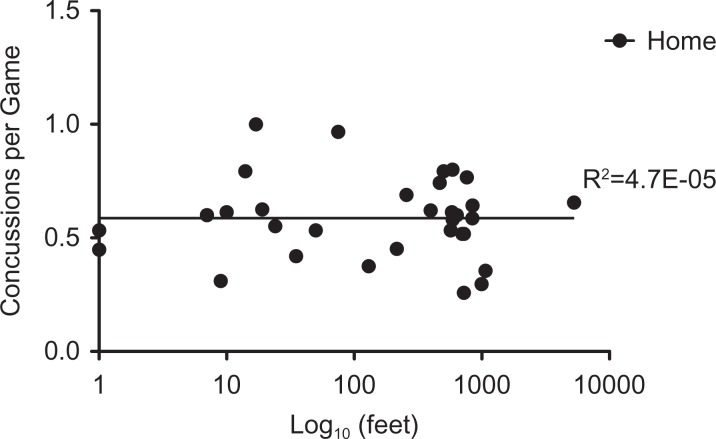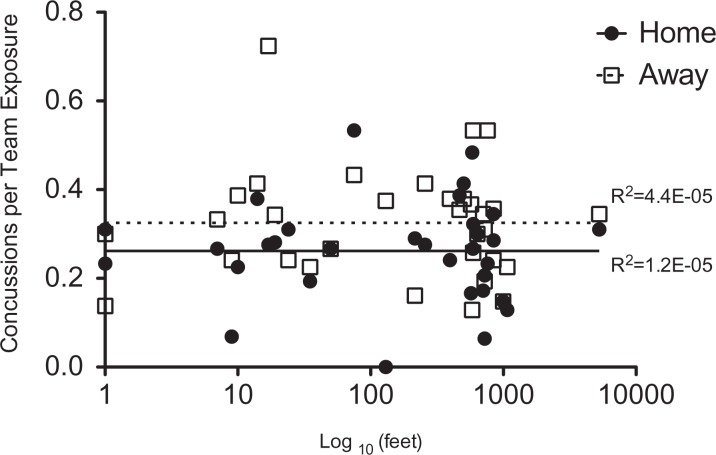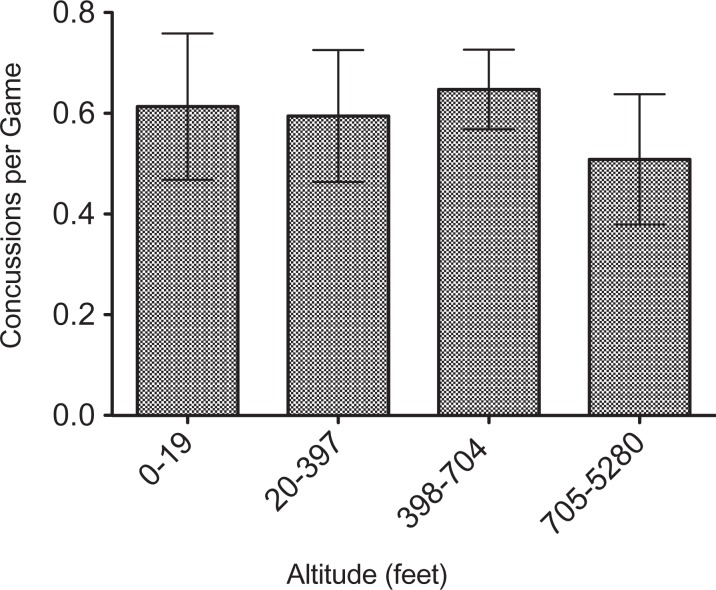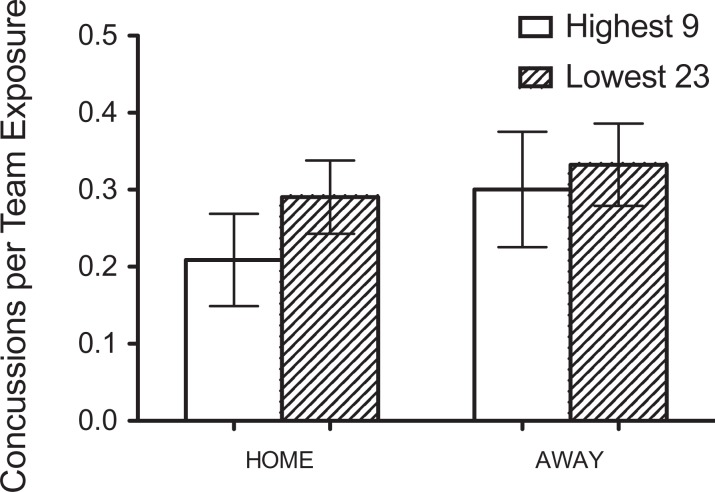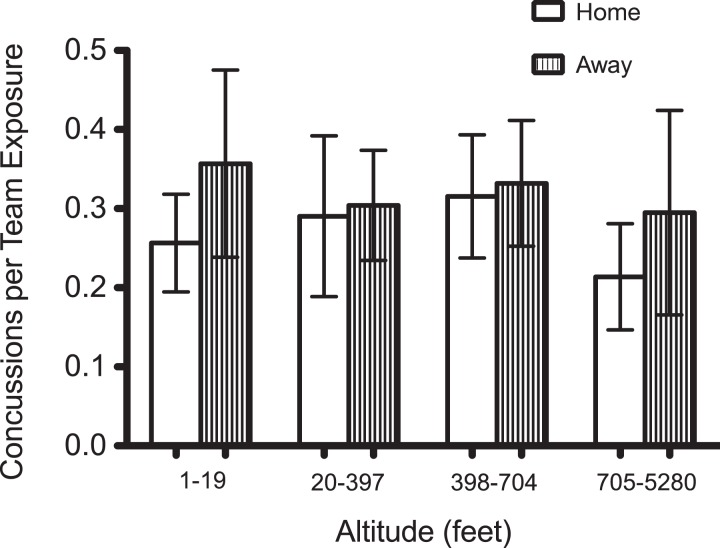Abstract
Background:
Despite the increased attention to sports-related concussion, the literature lacks information about the environmental factors that contribute to concussion incidence. Previous investigators have noted a decreased rate of concussion in football games played at higher altitude.
Purpose/Hypothesis:
The purpose of this study was to investigate whether the protective effects of altitude on concussion rate, as described by previous investigators, were due to acute effects of altitude exposure or chronic adaptations to training at altitude. Our hypothesis was that these protective effects are not attributable to relative cerebral edema that occurs in conditions of altitude-associated hypobaric hypoxia, known as the “slosh effect,” but rather result from long-term adaptations to training at altitude.
Study Design:
Descriptive epidemiology study.
Methods:
Athletes from the 2012, 2013, 2014, and 2015 National Football League (NFL) seasons were included in this analysis of publicly available data. Concussion rates were subdivided into 4 groups: (1) low-altitude teams playing below 644 feet (low-low), (2) low-altitude teams playing above 644 feet (low-high), (3) high-altitude teams playing below 644 feet (high-low), and (4) high-altitude teams playing above 644 feet (high-high).
Results:
Away teams had a significantly higher rate of concussion (0.32 concussions per exposure) compared with their home team counterparts (0.27 concussions per exposure; P = .03). Teams training and playing at high altitude had a 28% decreased concussion rate, which was significantly lower compared with concussion incidence rates for overall, low-low, and high-low groups (P < .05). In comparison, teams that trained at altitude but played below 644 feet had the highest rate of concussion, at 0.36 concussions per exposure (P < .05).
Conclusion:
These data indicate that living and training at altitude may have a protective effect on concussion rate, as evidenced by the significant reduction in the high-high group and the lack of an effect in the low-high group. However, teams from low altitude playing at high altitude did not have a statistically significant reduction in concussion rate. These results show that the slosh theory does not completely explain the effects of altitude on concussion incidence rate in the NFL. Further analyses are needed to investigate the true cause of altitude-induced protection in the NFL.
Keywords: head injuries/concussion, football (American), statistics, injury prevention
Sports-related concussion is a major cause of mild traumatic brain injury, an ailment that has received an unprecedented amount of attention in the past 10 years. A large percentage of sports-related concussions occur in American football at all levels of play. The repercussions of repeated sports-related concussions are still being investigated but are a point of concern for athletes, their families, physicians, and governing organizations. In recent years, the National Football League (NFL) has made significant strides to reduce concussion incidence in the form of rule changes, equipment upgrades, and enhanced reporting protocols. State governments, medical organizations, and amateur sports leagues have also taken measures to reduce concussion incidence in athletes.8 Despite the increased attention to sports-related concussion, the literature has a striking lack of information about the factors that contribute to concussion incidence.
Prior epidemiological investigations have implicated altitude as a major element that influences concussion incidence. Studies by Smith et al11 and Myer et al7 demonstrated that play at increased altitude is correlated with a decrease in concussion incidence rate in both high school and professional football players. Smith et al11 studied approximately 6000 concussive events in high school athletes across the United States and found that the all-sport concussion incidence was reduced by 31% in schools above 600 feet. Further, concussion incidence in football was 30% lower in schools above a set altitude threshold. Myer et al7 investigated this effect in the NFL and showed that playing football above 644 feet (196.3 m) conferred a 30% reduction in the odds of sustaining a concussion.
Both groups posited that the reduction in concussion incidence at altitude may be due to relative cerebral edema that occurs in conditions of altitude-associated hypobaric hypoxia. With increased volume, the brain has less space to move inside of the skull during an episode of head trauma. This may protect the brain from traumatic rebound inside the cranium, or “slosh effect,” during rapid acceleration and deceleration, therefore reducing the chance of sustaining a concussion. This slosh theory hypothesis draws from the fact that several animal species, most notably rams, have evolved to survive repeated high-impact blows to the head with minimal brain damage by slowing the release of blood from the cerebral vasculature into the body.2,10 In fact, Turner et al13 demonstrated that attenuating the slosh effect in rats by compressing jugular venous outflow during head injury acceleration and deceleration reduced histologic markers of brain injury by up to 65%.10 However, as Myer et al7 suggested, the degree to which hypoxia-induced vasogenic edema occurs at any altitude where football is played in the United States is questionable. Most acute physiologic adaptations to altitudes are apparent only above approximately 2000 feet.4
The human body adapts to altitude in both the acute and chronic settings. Acute changes include increases in minute ventilation and heart rate within minutes of hypobaric hypoxia. When humans live at high altitude for an extended period of time, the body responds in a myriad of ways in order to prevent hypoxic injury, a process known as acclimatization. It is well established, for example, that the body upregulates synthesis of erythropoietin to generate more red blood cells in order to ensure delivery of sparse oxygen to tissues.9 Research is being conducted on the therapeutic effects of repeated, controlled oxygen deprivation to tissues. The practice of ischemic preconditioning has been shown to reduce ischemic injury in cardiac myocytes, hepatocytes, and spinal cord neurons.6 Clearly, physiologic adaptations to hypoxic stress have protective effects.
Our investigation sought to further elucidate the effects of altitude on concussion incidence in the NFL. We questioned whether the effects observed by Myer et al7 and Smith et al11 were due to the acute effects of altitude exposure (the slosh mitigation theory) as they suggested or, rather, the long-term adaptations to living and training at altitude. We hoped to examine the findings established by Myer et al7 more completely by including the altitude at which players practice and play during the regular season (weeks 1-16) in the analysis of concussion incidence.
Methods
Data Collection
Frontline’s Concussion Watch,1 a publicly available web-based data source, was used to quantify all concussions incurred by players on an active roster for every regular season game (weeks 1-16) during the 2012, 2013, 2014, and 2015 NFL seasons. Concussion Watch aggregates data from the NFL Insiders show, team websites, and NFL injury reports. Concussions sustained during week 17 were not included in the analysis because of incomplete injury reporting. The NFL did not require teams that did not reach the playoffs to report concussions following week 17 of the regular seasons in the 2012, 2013, and 2014 seasons. All concussions sustained during practice were also removed from analysis to control for inconsistent reporting. A total of 1920 team exposures (15 games [1 bye per team] × 4 seasons × 32 teams) occurred over the course of the 4 seasons, with 28% (534) of exposures occurring at a stadium 644 feet or more above sea level. Team exposure was defined as the exposure each team takes on during a single game; 1 game counts as 2 team exposures.
Data
We made efforts to replicate the method used by Myer et al7 in order to verify and expand upon their findings. Team schedules were collected for all regular-season games via ESPN’s online NFL schedule grid.3 The team schedule was matched to the week of concussion on Frontline’s Concussion Watch1 to identify location of injury. It was assumed that all away teams for a given week traveled from the elevation of their stadium to the elevation of the home team’s stadium. This is based on the premise that teams generally practice at their stadium the week prior to game day, travel on Friday at the earliest for a Sunday or Monday away game, and return home immediately after the game.12 Stadium elevation was approximated via web-based resources that generate elevation data based on relative distance above sea level.5 The center of the game field was the established landmark for approximating stadium elevation. As defined previously by Myer et al,7 home stadiums located 644 feet or more above sea level were considered to be high altitude (University of Phoenix Stadium, Arizona; Mercedes Benz Stadium, Atlanta; New Era Field, Buffalo; Bank of America Stadium, Charlotte; Mile High Stadium, Denver; Lucas Oil Stadium, Indianapolis; Arrowhead Stadium, Kansas City; US Bank Stadium, Minneapolis; Heinz Field, Pittsburgh), whereas all other team stadiums, including Wembley Stadium in England, were considered low altitude. Smith et al11 and Myer et al7 established this 644-foot cutoff in previous altitude research evaluating effects on concussion incidence.
We calculated the overall concussion rate (total concussions divided by team exposures in the study period) as well as concussion rates for 4 separate groups: (1) low-altitude teams playing home or away below 644 feet (low-low), (2) low-altitude teams playing away above 644 feet (low-high), (3) high-altitude teams playing away below 644 feet (high-low), and (4) high-altitude teams playing home or away above 644 feet (high-high).
Statistical Analysis
Concussion rates were reported with 95% CIs. Nonoverlapping CIs were considered statistically significant with α = .05. All statistics were calculated with Microsoft Excel and PRISM. Spearman rho was calculated for concussions per game across the 32 stadiums. Wilcoxon signed rank was used to calculate significance for average overall concussion rate according to home and away status. Unpaired 2-tailed t tests were performed for stadium concussion rate analyses. A 1-way analysis of variance (ANOVA) was conducted to determine significance for acclimatization analysis and quartile altitude analysis. A 2-way ANOVA analysis was run for analysis of home and away concussion rate quartiles.
Results
A total of 569 concussions in 960 games or 1920 team exposures occurred over the course of the 2012, 2013, 2014, and 2015 NFL regular seasons (weeks 1-16). There were 155 concussions in 2012, 137 in 2013, 107 in 2014, and 170 in 2015.
Concussion rates at each stadium were analyzed across the 4 seasons. Away teams had a significantly higher rate of concussion (0.32 concussions per exposure) compared with their home team counterparts (0.27 concussions per exposure) (P = .03). No significant dose-response effect was noted with increasing altitude and concussion rate (R 2 = 0.005; P > .05) (Figure 1). This held true when we differentiated by home and away team status at each stadium (P > .05) (Figure 2).
Figure 1.
Concussion rate by altitude.
Figure 2.
Concussion rate by altitude and travel.
A quartile analysis for stadium altitude was performed with 8 stadiums within each quartile (0-19 feet, 20-397 feet, 398-704 feet, and 705-5280 feet). No significant difference was found between concussion rates across the altitude quartiles (P > .05) (Figure 3).
Figure 3.
Concussion rate by altitude quartile.
No significant difference was found in concussion rate between teams playing above and those playing below the 644-foot threshold (P > .05) (Figure 4). Similarly, we noted no significant difference in concussion rate when accounting for home and away status in the quartile analysis and when using the Myer et al7 threshold of 644 feet (P > .05) (Figures 4 and 5).
Figure 4.
Concussion rate by altitude threshold and travel.
Figure 5.
Concussion rate by altitude quartile and travel.
Of these 1920 team exposures, 534 were seen at the 9 stadiums above 644 feet while the remaining 1386 exposures were played below 644 feet. Exposures were then grouped into 4 categories according to location of training and play. The low-low group had 363 concussions across 1180 exposures, low-high had 66 concussions across 206 exposures, high-low had 75 concussions across 206 exposures, and high-high had 65 concussions across 328 exposures.
Our data indicated that teams training and playing at high altitude (the high-high group) had a significantly lower rate of concussion (0.20 concussions per exposure) compared with the low-low teams (0.31 concussions per exposure) (P < .05), the high-low teams (0.36 concussions per exposure) (P < .05), and the overall rate of concussion (0.29 concussions per exposure) (P < .05) over 4 NFL seasons. The low-high teams had more concussions (0.32 concussions per exposure) compared with the high-high teams, but the trend did not reach statistical significance (P > .05). In fact, a 28% decrease in concussion rate was found for the high-high teams compared with the overall concussion incidence rate (95%CI, 0.15-0.25). In comparison, teams that trained at altitude but played below 644 feet had the highest rate of concussion, at 0.36 concussions per exposure (P < .05). Teams that trained at low altitude and played either above or below altitude did not experience a statistically significant difference between concussion rates when compared with overall concussion rates (Figure 6).
Figure 6.
Concussion rate by acclimatization and travel. ***Statistically significant difference (P < .05).
Discussion
Our data demonstrated that teams from high altitudes had a significantly reduced concussion incidence rate when playing at high altitudes compared with total concussion rate across the 2012 through 2015 NFL seasons. Interestingly, teams from low altitudes playing at high altitudes did not show a significant change in expected concussion incidence rate. These results suggest that the slosh theory proposed by Myer et al7 is insufficient to completely explain the effects of altitude on concussion incidence rate in the NFL. If the slosh theory captured the phenomenon fully, we would expect all teams playing above 644 feet to show a significant reduction in concussion incidence, regardless of the altitude of their home city. That is, teams from low altitudes playing at high altitudes would be expected to have a similar reduction in concussion incidence rate to teams from high altitudes playing at high altitudes. In fact, if the slosh theory held true completely, we would expect low-high teams (which undergo an acute increase in altitude resulting in theoretically protective physiologic cerebral edema) to have a substantially lower concussion rate than all other groups. Our data indicate this is not the case.
Although we found an overall significant difference in concussion rates between home and away teams, this difference was not observed across the aforementioned 4 main altitude groupings (Figure 2). This further supports our theory that the observed variation in concussion rate is due in part to the physiologic effects of adapting to altitude rather than difficulties in adjusting to different altitudes during travel. We postulate that these effects may be quickly lost, as teams from high altitude playing at low altitude did not benefit from this protection.
The effect demonstrated by our results may be due to a combination of physiologic adaptations. Our data indicate that living and training at altitude may have a protective effect on concussion rate, as evidenced by the significant reduction in the high-high group and the lack of an effect in the low-high group (Figure 6). It appears, though, that these advantages are lost entirely when playing at lower altitudes; the concussion incidence rate in the high-low group was not significantly different from the expected rate and was significantly higher than that of the high-high group. This suggests that the protective effect of chronic adaptation to altitude may be lost in the amount of time it takes for a team to leave their home city and begin play below 644 feet (usually 2 days) or that the protective effect of altitude is due to both chronic and acute adaptations. It may be that this protection is afforded by increases in intracranial volume at altitude, combined with the longer term molecular adaptations that occur after acclimatization. Many of the studies investigating structural changes to the cerebrum were based on the effects of altitude associated with acute mountain sickness.14 It is clear that the mechanism of the protective effect of long-term altitude exposure on concussion incidence rates must be further elucidated.
Limitations
A major limitation in our data analysis is the use of 644 feet as a value to differentiate between high- and low-altitude teams. This value was established in the literature by Myer et al7 and was selected for the purpose of data analysis. Any physiologic changes that occur as a result of altitude may represent a spectrum, rather than a binary value as suggested by our analysis. This is especially relevant for the teams that play at altitude near this number. The Green Bay Packers play at 640 feet and are considered a low-altitude team, yet the Indianapolis Colts play at 714 feet and are considered a high-altitude team. It is unlikely that the Colts experience altitude-related physiologic changes much more significantly than the Packers. Further, past experiments have traditionally studied the effects of altitude and acclimatization on human physiology above 2000 feet. Therefore, we are unsure whether the altitudes in question are sufficient to cause a significant degree of physiologic adaptation. In addition, this study did not consider those teams that train at high altitudes during the preseason. While the NFL provides a useful laboratory to explore the factors that contribute to concussion incidence, the protective effect of altitude must be investigated in a larger data set: college football, for example, as several college teams play above 2000 feet. Moreover, it must be considered that our data were obtained from a public source that may be subject to underreporting and additional inaccuracies.
Conclusion
Limited research is available on the factors affecting concussion incidence in the NFL. Our work demonstrates that training and playing at altitude have a protective effect on concussion incidence; the slosh mitigation theory may not completely describe the protective effect of altitude on concussion incidence in professional football. We postulate that the protective effect of altitude may be attributable to both acute and chronic physiologic adaptations. These data provide useful insight into the increasing knowledge of environmental factors influencing concussion risk. The aim of this report was to provide professional and amateur sports communities with substantiated data they can use to assess individual risk. It is our hope that the principles discussed in our investigation can be applied to other at-risk sporting behaviors to mitigate the risk of injury.
Footnotes
The authors declared that they have no conflicts of interest in the authorship and publication of this contribution. AOSSM checks author disclosures against the Open Payments Database (OPD). AOSSM has not conducted an independent investigation on the OPD and disclaims any liability or responsibility relating thereto.
Ethical approval was not sought for the present study.
References
- 1. Concussion Watch. http://www.pbs.org/wgbh/pages/frontline/concussion-watch/. Accessed May 15, 2016.
- 2. Duma SM, Rowson S. The biomechanics of concussion: 60 years of experimental research In: Slobounov SM, Sebastianelli WJ, eds. Concussions in Athletics. New York, NY: Springer; 2014:115–137. [Google Scholar]
- 3. ESPN. NFL schedule grid 2016. http://espn.go.com/nfl/schedulegrid. Accessed May 10, 2016.
- 4. Fulco CS, Rock PB, Cymerman A. Maximal and submaximal exercise performance at altitude. Aviat Space Environ Med. 1998;69(8):793–801. [PubMed] [Google Scholar]
- 5. Google Maps Find Altitude. http://www.daftlogic.com/sandbox-google-maps-find-altitude.htm. Accessed May 7, 2016.
- 6. Hu S, Li F, Luo H, et al. Amelioration of rCBF and PbtO2 following TBI at high altitude by hyperbaric oxygen pre-conditioning. Neurol Res. 2010;32(2):173–178. [DOI] [PubMed] [Google Scholar]
- 7. Myer GD, Smith D, Barber Foss KD, et al. Rates of concussion are lower in National Football League games played at higher altitudes. J Orthop Sports Phys Ther. 2014;44(3):164–172. [DOI] [PubMed] [Google Scholar]
- 8. National Conference of State Legislators. Traumatic brain injury legislation. http://www.ncsl.org/research/health/traumatic-brain-injury-legislation.aspx. Accessed March 16, 2016.
- 9. Savourey G, Launay JC, Besnard Y, et al. Control of erythropoiesis after high altitude acclimatization. Eur J Appl Physiol. 2004;93(1-2):47–56. [DOI] [PubMed] [Google Scholar]
- 10. Smith DW, Bailes JE, Fisher JA, Robles J, Turner RC, Mills JD. Internal jugular vein compression mitigates traumatic axonal injury in a rat model by reducing the intracranial slosh effect. Neurosurgery. 2012;70(3):740–746. [DOI] [PubMed] [Google Scholar]
- 11. Smith DW, Myer GD, Currie DW, Comstock RD, Clark JF, Bailes JE. Altitude modulates concussion incidence implications for optimizing brain compliance to prevent brain injury in athletes. Orthop J Sports Med. 2013;1(6):23259 67113511588. [DOI] [PMC free article] [PubMed] [Google Scholar]
- 12. Spanberg S. Teams get early jump on travel planning. Sports Business Journal. http://www.sportsbusinessdaily.com/Journal/Issues/2012/10/15/In-Depth/Team-travel.aspx. Published October 15, 2012. Accessed January 22, 2016.
- 13. Turner RC, Naser ZJ, Bailes JE, Smith DW, Fisher JA, Rosen CL. Effect of slosh mitigation on histologic markers of traumatic brain injury: laboratory investigation. J Neurosurg. 2012;117(6):1110–1118. [DOI] [PubMed] [Google Scholar]
- 14. Wilson MH, Newman S, Imray CH. The cerebral effects of ascent to high altitudes. Lancet Neurol. 2009;8(2):175–191. [DOI] [PubMed] [Google Scholar]



